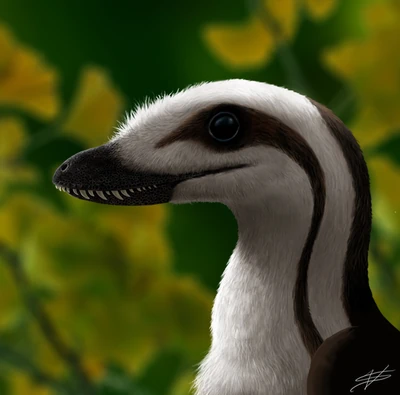| Sinornithosaurus
Fossil range: Early Cretaceous, 124.6 million years ago | |
|---|---|
 Life restoration of Sinornithosaurus. | |
| Scientific classification | |
| Kingdom: | Animalia |
| Phylum: | Chordata |
| Class: | Reptilia |
| Superorder: | Dinosauria |
| Order: | Saurischia |
| Suborder: | Theropoda |
| Family: | Dromaeosauridae |
| Genus: | Sinornithosaurus |
| Species | |
| |
Sinornithosaurus (derived from a combination of Latin and Greek, meaning 'Chinese bird-lizard') is a genus of feathered dromaeosaurid dinosaur from the Lower Cretaceous Period (late Barremian) of the Yixian Formation in what is now China.[1] It was the fifth non–avian feathered dinosaur genera discovered by 1999. It was collected from the Sihetun locality of western Liaoning. It was in Layer 6, lower (Chaomidianzi) Yixian Formation, Jehol Group.
Xu Xing described Sinornithosaurus and performed a phylogenetic analysis which demonstrates that it is basal, or primitive, among the dromaeosaurs.[2] He has also demonstrated that features of the skull and shoulder are very similar to Archaeopteryx and other Avialae. Together these two facts demonstrate that the earliest dromaeosaurs were more like birds than the later dromaeosaurs were. This contradicts one argument made by critics of the theory that birds evolved from dinosaurs.[3] See Temporal paradox (paleontology).
Description[]
Feathers[]
Both of the Sinornithosaurus specimens above preserved impressions of feathers. They were composed of filaments, and showed two features that indicate they are early feathers. First, several filaments were joined together into "tufts", like the structure of down feather. Second, a row of filaments (barbs) were joined together to a main shaft (rachis), making them similar in structure to normal bird feathers. However, they do not have the secondary branching and tiny little hooks (barbules) that modern feathers have, which allow the feathers of modern birds to form a discrete vane. In NGMC - 91 the feathers covered the entire body, including the head in front of the eye, the neck, wing - like sprays on the arms, long feathers on the thighs, and a lozenge - shaped fan on the tail like that of Archaeopteryx.[4]
Color[]
A 2010 study indicated that Sinornithosaurus may have had feathers which varied in color between significantly across different regions of the body, based on analysis of microscopic cell structures in preserved fossils.[5]
Classification[]
Sinornithosaurus was a member of the family Dromaeosauridae, a group of agile, predatory dinosaurs with a distinctive sickle-shaped toe claw, which also includes Deinonychus and Utahraptor. It lived about 125 million years ago in the Barremian age of the Lower Cretaceous period, which makes it among the earliest and most primitive dromaeosaurids yet discovered. The presence of vaned feathers on Sinornithosaurus is consistent with feather evidence from other Dromaeosaurs.
Sinornithosaurus is known from at least two species. S. millenii ("millennium Chinese bird-lizard") is the type species, described in 1999. A second species, S. haoiana ("Hao's Chinese bird-lizard") was described by Liu et al. in 2004 based on a new specimen which differed from S. millenii in features of the skull and hips.[6] An incredibly well-preserved microraptorian nicknamed "Dave" (specimen NGMC 91) may represent a third species of Sinornithosaurus, or a juvenile.
Discovery and specimens[]
Sinornithosaurus was discovered by Xu Xing, Wang Xiaolin and Wu Xiaochun of the Institute of Vertebrate Paleontology and Paleoanthropology of Beijing. An almost-complete fossil with feather impressions, was recovered from Liaoning Province, China, in the Yixian Formation; the same incredibly rich location where four dinosaurs with feathers were discovered previously, Protarchaeopteryx, Sinosauropteryx, Caudipteryx, and Beipiaosaurus. The holotype specimen is IVPP V12811, in the collection of the Institute of Vertebrate Paleontology and Paleoanthropology in Beijing, China.
Another specimen, NGMC - 91, is probably a juvenile Sinornithosaurus. Qiang et al. (2001) were reluctant to name NGMC - 91 because, although the specimen is completely articulated, almost all of the bones shattered when the fossil slabs were split, so that only the silhouettes of theses bones are clear in most of the part and counterpart. This obscured diagnostic skeletal features, which made the specimen's genus uncertain.[4] NGMC - 91, nicknamed "Dave", is in the collection of the National Geological Museum of China. It was collected in Fanzhangzi quarry, near Lingyuan City, Liaoning Province, China. This is around 130 km from the Sihetun locality. A specimen of the fish Lycoptera is also preserved near the foot of NGMC - 91.
Possible venomous bite[]
Main Article: Infectious Saliva and Venom in the Dinosauria